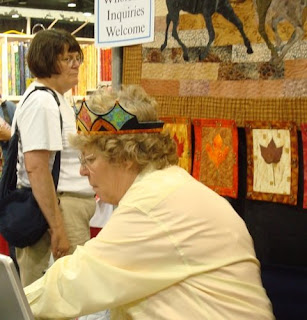
One of the greatest things about the Sacred Threads exhibition is that there is a place for all faiths and viewpoints. The exhibition is about spirituality and growth. The opening piece here is one call "A Gathering of Old Souls" by Judy Momenzadeh from Homestead, FL. Judy's work started out as a drop cloth for another piece she was inking. "I immediately knew what it wanted to be when I saw it. The spots which were created reminded me of a gathering of souls or spirits. I believe that we are connected through an energy which comes from our Creator."
Judy used painted and heated Tyvek, hand-dyed and commercial fabrics, beading, acrylic paints, free-motion and straight line quilting and couching to make her piece.
Perhaps part of the reason I liked "A Gathering of Old Souls" is that I consider my daughter an "Old Soul." Believe me, living with an "Old Soul" can be daunting. . . and infuriating at times when the "Old Soul" is a teenager. Of course, there may also be the fact that I love shades of orange, red and gold....
I think, perhaps, that this is a good place to start for tonight. The show has a connectedness and regardless of what your personal beliefs are, I think you would have been able to walk away from the show with something which touched you.
When I entered the show, I was handed a show booklet and a half sheet of blue paper which had spaces on it. You were to write down the artist's name and the piece and what you thought about the piece which spoke to you and why. Those sheets were then going to be given to the artists. I initially thought "Piece of cake." Right. I would have needed several sheets and therefore I gave up and didn't fill out any. I suppose this blog serves as my "sheets" to communicate what I thought.
The first quilt I came to which really spoke to me was "On Marriage", by Maxine Foster of Chapel Hill, NC.

Maxine designed this piece based on the poem by the same title by Kahil Gibran. The Rabbi at Maxine's wedding read it, and then later, her husband read it at their daughter's wedding, then the daughter read it at her brother's wedding (Maxine's son). Each block is a line in the poem and each line represents a stanza.
"You were born together, and together you shall be forevermore.
You shall be together when the white wings of death scatter your days.
Aye, you shall be together even in the silent memory of God.
But let there be spaces in your togetherness."
Part of the reason I like this is the symbolism of using a block based on the traditional log cabin block which represented the hearth in the home. Traditionally, the central square is red, to represent the hearth. Sometimes in these blocks the hearth burns, sometimes it uses a cooler fabric. Sometimes the hearth isn't there at all, but absorbed into the other pieces which represent an openness.
I also like the non-traditional hanging. To me, the block types, sizes and how they are hung represents life and marriage. It isn't always equal, sometimes parts are big and sometimes small, but the pieces together make a comprehensive whole.
This last piece tonight, I just thought was really neat and showed a connectedness, in addition to change. Karen Bates, of Ashland, OR made this quilt called "Reaching for Torah." Her short statement says "This quilt celebrates the opportunity for women to read from the Torah in synagogues today."
Her longer statement is a little more revealing: " Reaching for Torah expresses both frustration and gratitude for my Jewish heritage. I collaged both Hebrew and English pages from a Passover Haggadah, creating an original fabric. I layered this with tulle to mute the harshness of the words underneath. The Young woman reaching for the Torah reflects my joy that women are now allowed equality in the synagogue. To connect with my ancestors, I incorporated lace hand-crafted by my Romanian great grandmother."
I think I like this one both for the joy which is so nicely expressed here, but also in understanding to some degree how women have struggled to be allowed an active role in the practice of religion. I especially liked the use of the lace to make the connection to the ancestresses in general and her direct line in particular.
I have tried to obtain permission for the photos of the work I have shown here, but I wasn't able to get it for Maxine Foster and Karen Bates. I am waiting to hear from some of the entrants and will again, hopefully, be posting more in the next few days...hopefully when I don't have to fight a teenager for the use of the computer!


































 Where I can, I like to use native plants, but I'm no plant snob. However, many of the trees and shrubs I have put in are wonderful and under utilized. Using natives also gives the added benefit of usually requiring less care than using a non-native plant as well as providing good materials for cover and food for local fauna.
Where I can, I like to use native plants, but I'm no plant snob. However, many of the trees and shrubs I have put in are wonderful and under utilized. Using natives also gives the added benefit of usually requiring less care than using a non-native plant as well as providing good materials for cover and food for local fauna.








